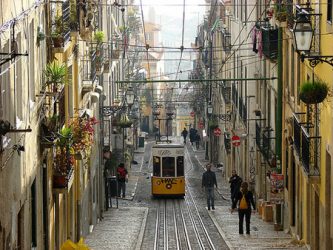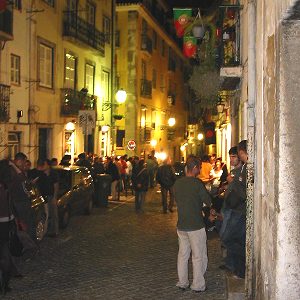GUEST POST OVERVIEW: Love me some Lisbon! Or at least, I love the idea of the city and photographs I’ve seen of it. In the mean time, I’ll just have to visit it virtually through this new guest post by Aleix.
. . . . . . .
Lisbon is one of Europe’s most vibrant cities, although it’s not as obvious as in some other places. The best of the Portuguese capital’s nightlife is hidden in the Bairro Alto, one of the most charming, symmetrical and emblematic districts in the city.

(Lisbon street photograph courtesy of Absolut Portugal)
In fact, some would say that it’s even better because a lot of it takes place in the streets, with people drinking there and having a good time surrounded by the charming narrow and winding streets. This scenario mostly takes place in the Bairro Alto, one of Lisbon’s central districts.
. . . . . . .
The Barrio Alto
The Bairro Alto is a part of town that’s up on a hill, as its name suggests, and you can get there by walking up the steep and narrow roads or by taking any of the elevators that will take you to the top, such as the Elevador da Bica on the south side or Elevador da Gloria on the east side.

Whether it’s legal or not, a lot of people drink on the streets with plastic cups, whether it’s beer or spirits, and many of the bars have open terraces. The Bairro Alto is, as you’ve probably gathered, the main area for restaurants, bars and clubs in the city, which means you don’t have to walk far if you’ve just come for a meal and you’re looking to go and have a few drinks and a dance.
(Barrio Alto street photography courtesy of Poramora Lisboa)
Most bars are open until 3am and clubs until sunrise, so if you come from a northern European country where the timetables are a lot earlier, make sure you don’t get there too early because there’ll be nobody there, unless your idea of fun is a party for one!
. . . . . . .
Fado Music in Lisbon

Also, aside from the lively nightlife, if you’re looking for something a bit more relaxed and traditional, you’ll find plenty of fado houses around here. For those of you that are not familiar with fados, they are Portugal’s national music genre, music that’s no more than a voice and a guitar, singing about sadness, melancholy and destiny, the latter being the English translation to ‘fado’.
Fado houses are very popular around here, and are usually bars or venues that you can go to, pay an entrance fee (or not, if you’re lucky to find one without) and just go and enjoy the performance in a quiet and somber atmosphere, only to be disrupted by the fervent applause at the end of each song.
. . . . . . .
Some Great Bars and Clubs in Lisbon
If you’re not one for discovering the bars and clubs for yourself and you want to go to one that you’ll know you’ll have a great time in, A Capela (rua da Atalaia) is a great place to relax, with lounge-style atmosphere, nice drinks and great service. If you want something more lively, head to Bedroom Bar (rua do Norte) and sample its great cocktails and beers.
It’s called Bedroom because there are actual beds that you can lie on with your friends or partner while you enjoy a drink. Lastly, for clubs try Incognito, a bar that honours its name by having no name on the door, instead you having to knock to get in. Anything from pop to rock and techno is played here, a really popular choice with locals and tourists. Find it at rua dos Polais de São Bento, 37.
About the Author: Aleix Gwilliam is a 24 year old from Barcelona who looks English but thinks like a Catalan. He enjoys traveling, especially on old Czech trains, and trying to start conversations in Hungarian with people at Pecs station, even though his Hungarian is as good as his Bulgarian, in other words, not very good. He’s a trier.
EXPLORE SOMEWHERE NEW
Nothing found.
BUY A PRINT
All photos on this site are available as limited edition fine art photographic prints. Please get in touch for sizes and rates.

